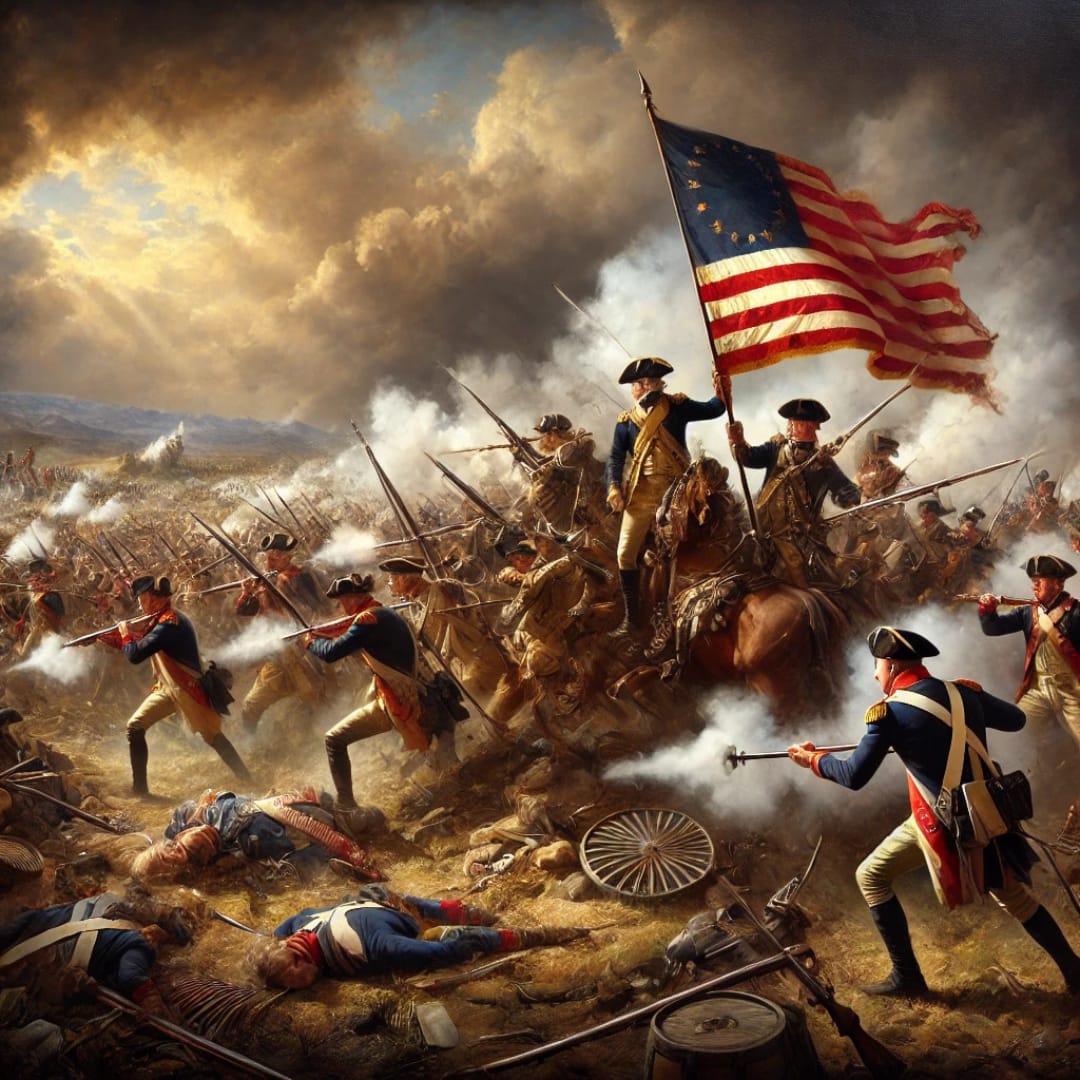Introduction
The American Revolution (1775–1783) was a watershed moment in world history, establishing the United States of America. The colonial struggle against British control eventually resulted to independence. The dispute was fuelled by escalating tensions between the Thirteen American Colonies and the British Crown over problems such as taxation without representation, colonial trade restrictions, and British political control. The revolution was not simply a struggle for self-government, but also for individual rights, democratic principles, and economic liberty. The war’s outcome had far-reaching implications, influencing democratic movements around the world and changing the geopolitical scene of the time.
Causes of the American Revolution
The American Revolution did not occur quickly; rather, it was the result of decades of rising dissatisfaction and conflict between Britain and its colonies. Several major causes contributed to the onset of war:
- Taxation Without Representation
One of the most significant causes was the imposition of taxes by the British government without giving the colonies any representation in Parliament. The phrase “No taxation without representation” became a rallying cry for the colonists who opposed these policies. The British government argued that the colonies were “virtually represented” in Parliament, but the colonists rejected this notion, demanding direct representation in the legislative process.
Key Taxation Policies That Led to Unrest:
- The Sugar Act (1764) imposed duties on sugar, molasses, and other imported goods with the goal of reducing smuggling and increasing British revenue. However, it infuriated the colonists, who considered it as an unjust tax imposed without their permission.
- The Stamp Act (1765) required colonists to purchase special stamped paper for legal documents, newspapers, and playing cards. This act affected almost all colonists and led to widespread protests. In response, the Sons of Liberty, led by Samuel Adams, organized resistance, and the Stamp Act Congress united representatives from different colonies in opposition. Although the act was revoked in 1766, Britain simultaneously passed the Declaratory Act, asserting its right to tax the colonies whenever it wanted.
- The Townshend Acts (1767) imposed duties on glass, lead, paper, paint, and tea, with revenue designated to pay British officials in the colonies, thereby reducing colonial control over governance. This led to organized boycotts of British goods and violent confrontations. Though most of the taxes were repealed in 1770, the tax on tea remained a point of contention.
- The Tea Act (1773) and the Boston Tea Party granted the British East India Company the right to sell tea directly to the colonies, bypassing colonial merchants. While it reduced the price of tea, it reinforced Britain’s authority to tax the colonies, sparking outrage. In retaliation, American patriots disguised as Native Americans staged the Boston Tea Party, dumping an entire shipment of tea into Boston Harbor. Britain responded with the Coercive Acts (1774), also known as the Intolerable Acts, which further restricted colonial freedoms and intensified resistance.
The Proclamation of 1763
The British Crown issued the Proclamation of 1763 following its victory in the French and Indian War, primarily to restore peace between Native American tribes and colonial settlers. The proclamation restricted colonial development west of the Appalachian Mountains and reserved those areas for Indigenous peoples. The British government aimed to prevent further conflicts like Pontiac’s Rebellion (1763), in which Native American tribes resisted British encroachment on their lands. However, the law was deeply unpopular among American colonists, many of whom had already invested in or planned to settle westward. Land speculators, including influential figures like George Washington, saw the restriction as a direct threat to economic opportunity.
The Quartering Act (1765)
The Quartering Act of 1765 was a law issued by the British Parliament that required American colonists to provide housing, food, and other necessities to British soldiers stationed in the colonies. The act was implemented to minimise Britain’s financial burden by moving the costs of maintaining its troops to the colonies. While some colonial assemblies complied, others resisted, seeing it as a violation of their rights and an indirect kind of taxation. The ordinance was especially hated in cities such as New York, where tensions between British troops and residents regularly flared. Many colonists saw the compulsory quartering of soldiers as an extension of British oppression, escalating anti-British feeling. The opposition to the act contributed to the growing unrest that eventually led to the American Revolution. In 1774, an even stricter version of the act was passed as part of the Coercive Acts, intensifying colonial resistance against British rule. This ordinance obliged colonial houses to provide food and shelter for British soldiers stationed in America, adding to the growing hostility of British rule. Tensions rose when British soldiers opened fire on a gathering of protesting colonists in Boston, killing five. This incident, widely publicized by colonial leaders like Paul Revere, fuelled anti-British sentiment.
The Boston Tea Party (1773)
In response to the Tea Act, which granted the British East India Company a monopoly on tea sales, American patriots disguised as Native Americans dumped an entire shipment of tea into Boston Harbor. Britain responded with the Coercive Acts (1774), which further limited colonial autonomy.
The First and Second Continental Congresses
The First Continental Congress (1774) was called in reaction to the British Parliament’s adoption of the Coercive Acts, which sought to punish Massachusetts for the Boston Tea Party. Delegates from twelve of the thirteen colonies (excluding Georgia) gathered in Philadelphia to plan a coordinated reaction to British policies. The Congress petitioned King George III for redress of complaints, supported a colonial boycott of British products, and formed the Continental Association to enact economic opposition. However, Britain refused to compromise, escalating tensions. As the situation progressed into open combat, the Second Continental Congress (1775-1781) met and assumed the function of a de facto national government. It organized the Continental Army, appointing George Washington as its commander-in-chief, and authorized the issuance of currency to fund the war effort. Initially seeking reconciliation with Britain, the Congress sent the Olive Branch Petition to the King, which was rejected. As hostilities grew, the Congress moved toward independence, drafting and adopting the Declaration of Independence on July 4, 1776, formally severing ties with Britain. The Second Continental Congress continued to govern the colonies throughout the war, laying the groundwork for the future United States government through the Articles of Confederation in 1781. In response to British actions, colonial leaders convened in 1774 and 1775, calling for resistance, forming militias, and eventually drafting the Declaration of Independence in 1776.
Key Battles of the American Revolution
The American Revolution was shaped by numerous battles, each playing a crucial role in determining the war’s outcome. These battles showcased the resilience of the colonial militias and the strategic brilliance of their leaders, ultimately leading to American independence. The war officially began in 1775 and was marked by a series of battles that shaped its outcome. Below are some of the most crucial battles:
- Battle of Lexington and Concord (April 19, 1775)
This fight, also known as “the shot heard ’round the world,” officially began the American Revolutionary War. British troops were sent to seize colonial weapons stored in Concord, but local militias had been warned by riders such as Paul Revere and William Dawes. The first confrontation took place in Lexington, where the outnumbered militia briefly engaged the British army before fleeing. As the British moved toward Concord, they encountered stronger resistance at the North Bridge, forcing them to retreat to Boston under heavy fire from colonial militias. This battle revealed the colonists’ readiness to resist British rule with force, sparking widespread armed warfare.
- Battle of Bunker Hill (June 17, 1775)
Although technically a British victory, the Battle of Bunker Hill proved the colonial forces could stand up to the well-trained British army. Colonial militias fortified Breed’s Hill, which overlooks Boston, in preparation for a British assault. The British launched repeated frontal assaults, suffering heavy casualties before finally forcing the colonists to retreat due to a lack of ammunition. Over 1,000 British casualties were recorded during the conflict, while approximately 400 Americans were killed. Despite losing terrain, the colonists gained confidence in their capacity to confront the British, resulting in increasing support for the revolutionary cause. Despite a British triumph, the colonial soldiers proved to be a tough opponent.
- Battle of Saratoga (September-October 1777)
A major turning point in the war, the Battle of Saratoga consisted of two significant engagements in upstate New York. British General John Burgoyne’s soldiers, seeking to split the colonies by capturing control of the Hudson River Valley, were hampered by tough terrain and continual harassment by American troops. On September 19, 1777, the first battle at Freeman’s Farm saw Burgoyne’s forces advance but suffer heavy losses. On October 7, 1777, at the Battle of Bemis Heights, American forces led by General Horatio Gates and Benedict Arnold overwhelmed the exhausted British troops, forcing Burgoyne’s surrender on October 17. This victory convinced France to officially enter the war as an ally of the colonies, providing crucial military and financial support. This American victory was a turning point in the war, convincing France to join the conflict as an ally of the colonies, providing crucial military and financial support.
- Battle of Yorktown (September-October 1781)
The Battle of Yorktown was the pivotal battle that effectively ended the American Revolution. British General Lord Cornwallis established a defensive position in Yorktown, Virginia, awaiting reinforcements. However, American and French forces, led by General George Washington and French General Comte de Rochambeau, laid siege to the city. The French navy, under Admiral François de Grasse, blocked British reinforcements from arriving by sea. After weeks of bombardment and failed breakout attempts, Cornwallis surrendered on October 19, 1781. This decisive victory led to the signing of the Treaty of Paris (1783), in which Britain formally recognized American independence. The last major battle of the war, in which General George Washington, with French support, forced British General Cornwallis to surrender. This effectively ended the war and resulted in the Treaty of Paris (1783), by which Britain formally recognized American independence.
The Impact of the American Revolution
The American Revolution had a significant impact on the world, transforming the political, social, and economic landscape. It inspired numerous independence movements, particularly in France, Latin America, and the Caribbean, where the ideals of liberty and self-governance took root. The revolution revealed that a determined people can remove oppressive regimes and establish democratic governments. The triumph of the United States weakened the British Empire, changing global power relations and driving constitutional reforms in the UK and abroad. Additionally, the economic shifts that followed the war allowed America to freely expand trade, which fuelled economic development and innovation.
Conclusion
The American Revolution was a defining moment in history, setting the stage for the creation of a new nation based on liberty, democracy, and self-determination. It was not just a war for independence but a revolution that reshaped political ideologies and governance. The sacrifices made by the revolutionaries ensured that the United States would emerge as a symbol of freedom, influencing movements for self-rule and democracy worldwide. The revolution’s legacy continues to inspire struggles for justice and equality, making it one of the most significant events in modern history.



